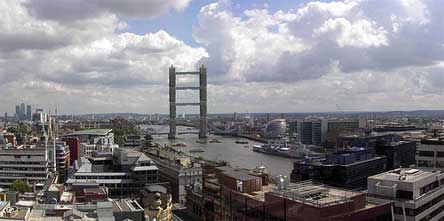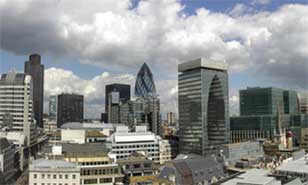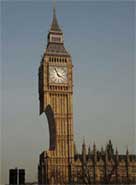Tomas Klassnik is a graduating student from the Royal College of Art and is contributing to Airspace, a group show about London’s skyline for the Architecture Foundation in London.
The capital’s profile is set to be radically redesigned as skyscrapers, towers and tall building are planned all over the city.
The “Airspace� exhibition asks thus what kind of city is awaiting us. Londoners are invited to respond and can vote online for their favourite panorama, take part in a debate and get an idea of the London to come through animations, interviews and films.
 “Augmenting” Tower Bridge to skyscraper height
“Augmenting” Tower Bridge to skyscraper height
Tomas Klassnik‘s particular section, called More-numents for London, focuses on London’s protected viewing corridors and how raising the dome of St Paul’s by 1m would create enough new potential volume for the capital to build 15.25 canary wharfs. It then goes on to imagine how London’s other historic monuments could evolve to compete with more recent London icons.
London’s Regional Planning Guidance Note 3, defines ten strategic views. Designed to protect key London icons by constraining building development within geometrically defined viewing corridors. 8 of these are towards the dome of St Paul’s. These viewing corridors restrict building heights across large areas of London, in fact if you calculate the area covered by the corridors over 10 million square metres are affected.
Despite these restrictions, new building inevitably distract from St Paul’s. Tomas Klassnik proposes to allow St Paul’s to compete and grow.
Due to the large area affected by the viewing corridors even a 1m increase in the height of the dome would create an extra 6.862 million cubic metres of potential building volume, the equivalent of 25,412 new homes.
“Augmenting” historic landmarks could thus be in our and their interests, enabling them to compete with the likes of the London Eye or The Gherkin. Perhaps London’s other landmarks could evolve too. We could have a Truly Tower of London, a Buckingham Pal-arch, or a Twin Towers Bridge (image above). Hybrid monuments that put up a fight and resist being eclipsed by their newer neighbours.

 Gherkin City Cut: interpreting how London’s skyline might look if the Gherkin was given similar protection status as St Pauls and other listed landmarks
Gherkin City Cut: interpreting how London’s skyline might look if the Gherkin was given similar protection status as St Pauls and other listed landmarks
What if the Gherkin becomes London’s most important landmark? Requiring adjustments to the trajectories of the London protected viewing corridors. Could this justify changes to even the most cherished monuments from London’s past?
I uploaded on flickr the images that Tomas has kindly sent me to illustrate this post.
